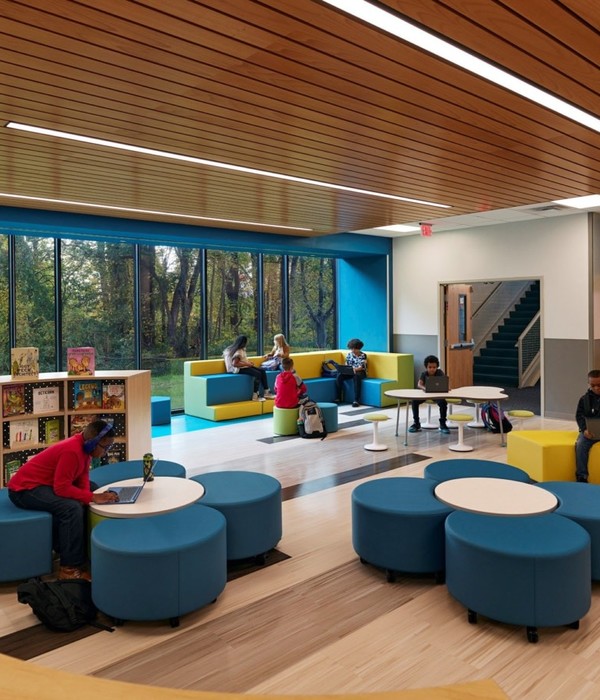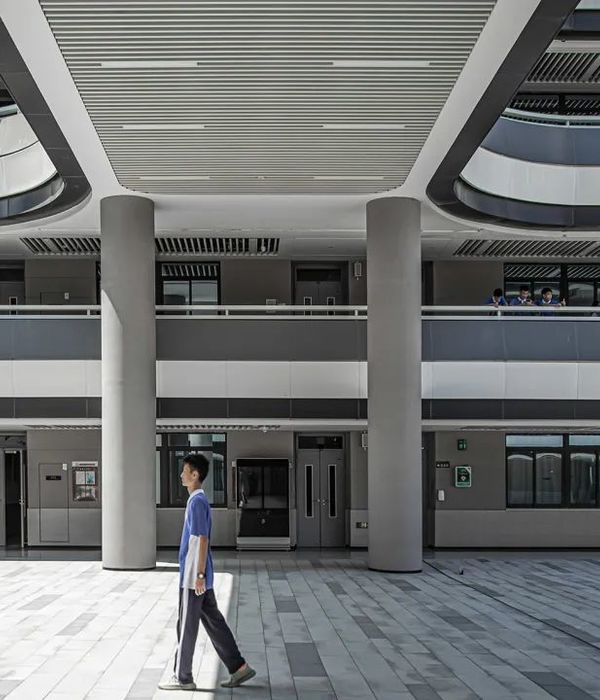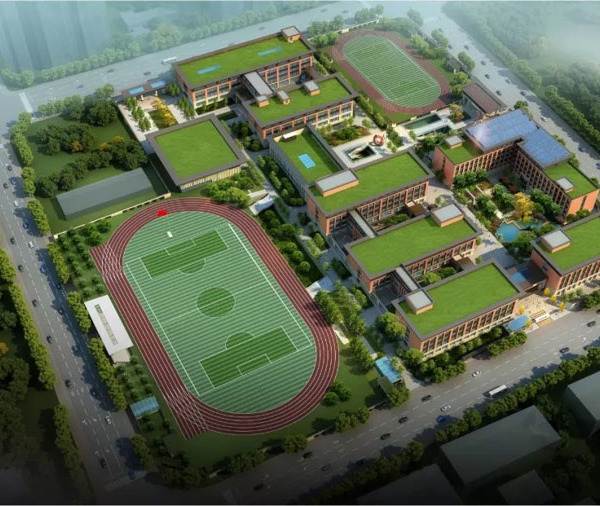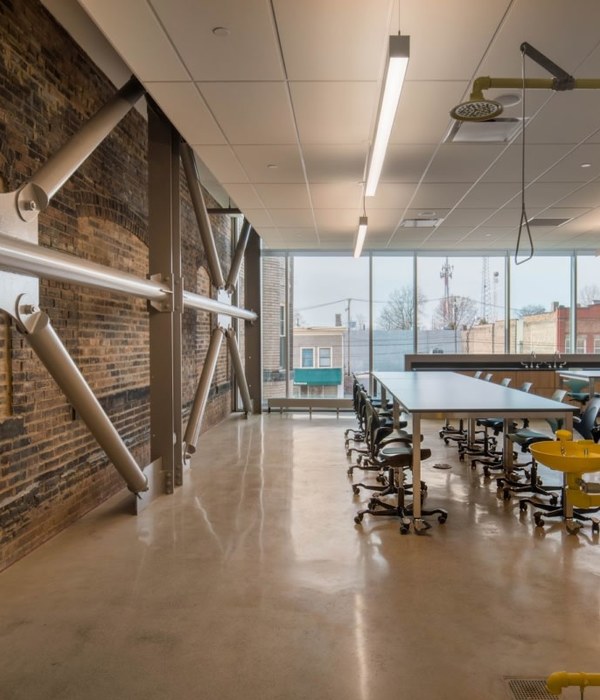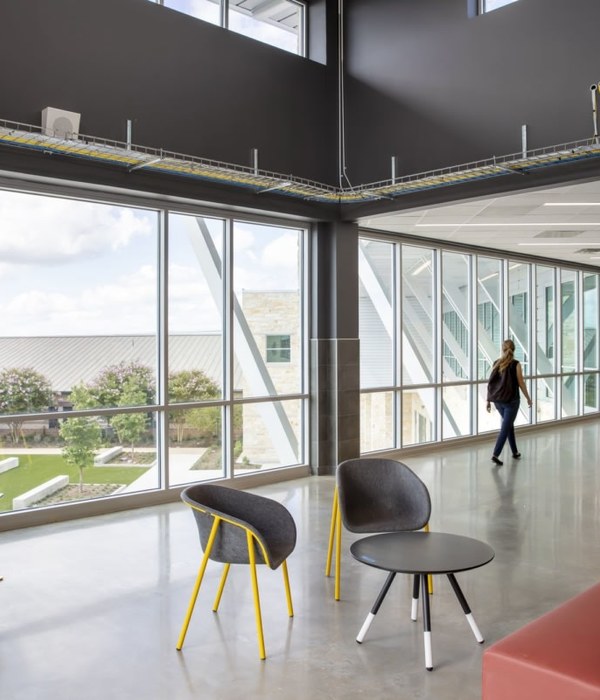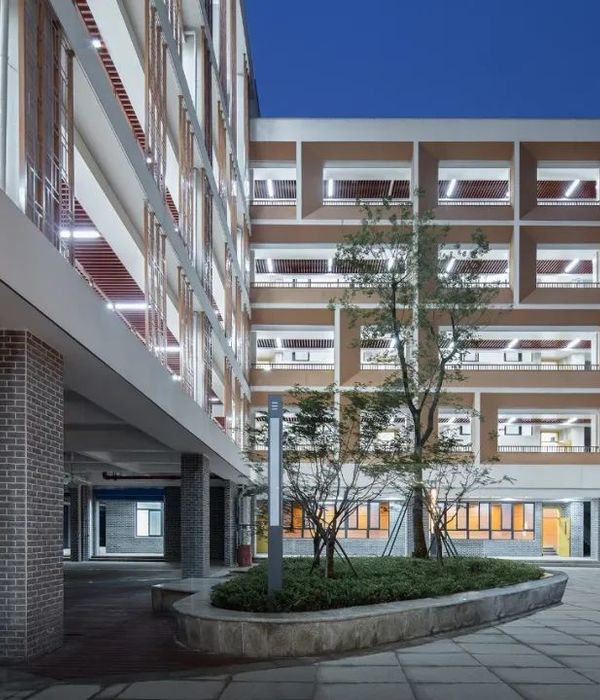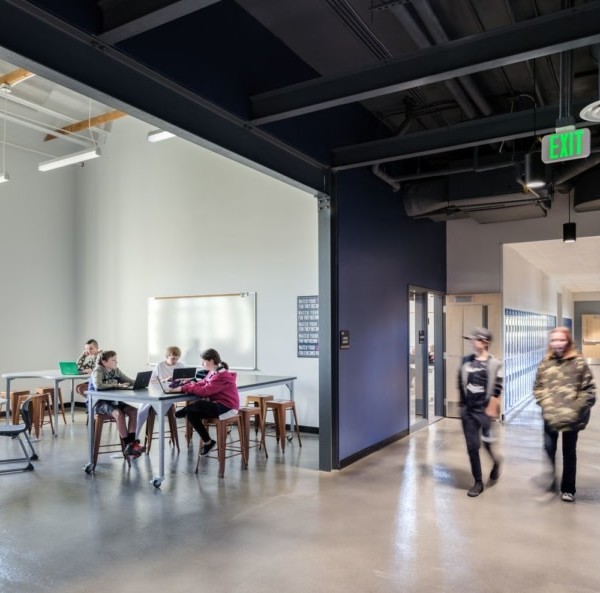01. 背景 Background
为支持宜宾双城建设,作为省内唯一的语言类高校,四川外国语大学成都学院入驻宜宾大学城。新校区规划用地面积500亩,学生12000人,总建筑面积约34万平方米。校园选址位于大学城中心,南临龙头山景区,自然景观条件优越。
In order to support the construction of Twin-City Development in Yibin, Chengdu Institute Sichuan International Studies University, as the only language university in the province, has Settled in Yibin University Town. The planned land area of the new campus is 500 mu, with 12000 students and a total construction area of about 340000 square meters, The campus is located in the center of the University Town, adjacent to Longtou mountain scenic spot in the south, with superior natural landscape conditions.
▼依山傍水——暮色中的川外宜宾校区 Situated at the foot of a hill and beside a stream—Campus at Dusk ©章勇
▼项目整体鸟瞰,Overall aerial view of the project ©章勇
02. 共享之“环” Shared “Ring”
针对语言类文科院校自由开放、合作交流的学科特色,我们试图找到一种形式,让相关学科可以互相交叉,互为渗透,能容纳使用功能的灵活性和综合性。结合场地等现实条件,融合式创新平台成为设计的最优选择。
In view of the subject characteristics of open and cooperative in language liberal arts colleges, we try to find a form in which disciplines can cross and penetrate each other, accommodating the flexibility and comprehensiveness of functions. Combined with the actual conditions of the site, the integrated innovation platform has become the best choice for the design.
▼核心区的环廊,Ring gallery in core area ©章勇
创新平台将教学楼、礼堂、图书馆连接,形成一个“环”。建筑空间紧密联系,场地也获得最大化的完整空间。“环内”自然成“园”,以瀛瀛湖面居中铺开,建筑围绕水面呈放射状排列,留白处采用堆山叠石、理水造池的设计手法,打造园林式的氛围。
▼形体分析,Design analysis ©TJAD
The innovation platform connects the academic building, hall and library to form a shared “ring”. The architectural space is closely linked, and the site also obtains the maximum holonomic space. The inner of the “ring” naturally becomes a “garden”, which is centered on the placid lake, with the buildings arranged radially around the water. The design techniques of piling up hills and dredging waterways are used to create garden atmosphere.
▼园林化的氛围,Garden atmosphere ©章勇
▼中心景观顶视图,Top view of central landscape ©章勇
“环”本身提供三个层次的空间交流模式:底层是开放的架空敞廊,形成内外渗透,中心景观被引入校园生活区,由此产生内外联动;中间层为风雨廊,环通教学楼、图书馆、礼堂;顶层为屋顶花园,身在其中,核心区景观尽收眼底。
The shared “ring” itself provides three levels of spatial communication mode: the bottom floor is an open overhead corridor, forming internal and external infiltration, and the central landscape is introduced into the other areas, resulting in internal and external linkage; The middle floor is a storm corridor, connecting the teaching building, library and hall; The top floor is the roof garden, in which you can have a panoramic view of the core area.
▼入口广场,Entrance square ©章勇
▼校园建筑外观,School building exterior view ©章勇
“环”与主体建筑的衔接部分做了公共化处理,力求将廊与主体建筑内外一体化,增加共享空间。如礼堂与环廊的交接处的二层取消礼堂边界,对环廊敞开,将开放空间还给学生;图书馆以咬合的姿态将环廊纳入自身的空间体系之中,公共的环廊成为阅览空间的一部分;在“环”的收尾处的第三教学区设有大台阶连接室外与二层环廊,限定出广场上的圆形舞台,可供学生社团活动与才艺展示。
The connection between the shared “ring” and the main buildings has been made public, striving to integrate the corridor with the inside and outside of the main building and increase the shared space. For example, the second floor at the junction of the hall and the ring corridor cancels the auditorium boundary, opens to the ring corridor, and returns the open space to students. The library brings the ring corridor into its own space system with a bite attitude, and the public ring corridor becomes a part of the reading space; The third academic buildings at the end of the “ring” is equipped with large steps connecting outdoor and the ring corridor,defining a circular stage on the square for student community activities and talent display.
▼“环”收尾处的大台阶与广场,Steps and square at the end of the “ring” ©章勇
▼图书馆与环廊交接,Connection between Library and the “ring” ©章勇
▼通过小中庭,异形楼梯,增添了空间的趣味性,破除了礼堂的壁垒 ©章勇 Through the small atrium and special-shaped stairs, the interest of the space is added and the barriers of the auditorium are broken
▼中庭,Atrium ©章勇
03. 场所记忆 Place · Memory
在设计之初,我们首先关注的是场地塑造与地形回应,我们充分利用基地现状的自然特征,意图将规划作为场地的人工介入,强化来访者对地域自然环境的感知,而非挖山填池,阻断或破坏这一体验。在此次设计中,我们通过对校园场地标高、坡度、坡向的条件分析,以土方总体平衡为约束,最小挖填方为目标。场地中部最大的低洼区域设计为校园核心景观湖,主要建筑多位于挖方区域。我们将建筑以向上生长的态势充分保留了原始地貌特点,完成了一次人工对自然的修补。
In the early stage of design, we first pay attention to the site shaping and terrain response. We make full use of the natural characteristics of the current situation and intend to take the design as the manual intervention of the site to strengthen the visitors’ perception of the regional natural environment, rather than to block or destroy the experience. We analyze the campus site elevation, slope and slope direction, taking the overall balance of earthwork as the constraint and the minimum excavation and filling as the goal. The largest low-lying area in the middle of the site is designed as the core landscape lake , and most of the main buildings are located in the excavation area. We have fully retained the original geomorphic features with the upward-growth of the architecture, and completed an artificial repair of nature.
▼原始地形与设计的叠加,Superposition of original terrain and design ©TJAD
基地北高南低,遵循上位规划,主入口广场设置在北侧高处。步入校园,湖面一览无余,视野开阔。恰是地形的落差为校前区提供了俯瞰校园全景的最佳视角。
The base is high in the north and low in the south. According to the upper planning, the main entrance square is set at a high place in the north. Entering the campus, the lake has a panoramic view and a wide field of vision. It is the drop of the terrain that provides the best perspective for the front area to overlook the panoramic view of the campus.
▼场地剖透视,Site section Perspective ©TJAD
入园望去,建筑与场所景观融为一体,远处的山峦在视线可及之处,与核心区建筑一起倒影于湖面,形成一幅静谧的山水画卷。
Looking over the campus, the architecture and the landscape are integrated. The distant mountains are within sight and reflected on the lake together with the buildings in the core area, forming a quiet landscape painting.
▼入园望景,View of the entrance ©章勇
▼中心景观,Central landscape ©章勇
04. 材料营造 Material construction
实现建筑在地性的另一策略是材料的文化意义,而宜宾名扬天下的竹文化作为材料层面的“变量”,引发了我们深入思考。
Another strategy to realize the locality of architecture is the cultural significance of materials, and the famous bamboo culture of Yibin, as a “variable” at the material level, has aroused our in-depth thinking.
▼远观图书馆,A distant view to the library ©章勇
▼顶视图,Roof top view ©章勇
▼中庭天窗,Skylight ©章勇
核心区建筑立面的构成元素延续了宜宾的竹文化特色,以竖向线条象征翠竹挺立,但材质却突破了对传统的模仿:图书馆采用“玻璃幕墙+穿孔铝板”双层幕墙系统,经过穿孔率的反复实验对比,最终确定穿孔率为50% ,保证室内空间良好的透光性。窗户开启部分隐藏在“竹节”处(即两片穿孔板相并的位置),立面干净纯粹。遮阳格栅的排列遵循“相对无序”的原则,力求体现建筑中的自然之美。
▼图书馆节点详图,Detail drawing of library node ©TJAD ©章勇
The constituent elements of the architecture facade in the core area continue the bamboo cultural characteristics of Yibin, symbolizing the upright bamboo with vertical lines, but the material breaks through the imitation of the tradition: the library adopts the double-layer curtain wall system which combines glass curtain wall and perforated aluminum plate. After repeated experimental comparison of the perforation rate, it is finally determined that is 50%, so as to ensure good light transmittance of the indoor space. The opening part of the window is hidden at the “bamboo joint” ( the position where two perforated plates are combined), and the facade is clean and pure. The arrangement of sunshade grille follows the principle of “relative disorder” and strives to reflect the natural beauty of architecture.
▼室内空间,Interior view ©章勇
而礼堂的立面则采用连续的竖向长窗来呼应竹文化,局部采用竖向的浮点玻璃百叶,在室内形成丰富的光影效果。
The facade of the hall adopts continuous vertical long windows to echo the bamboo.Vertical floating-point glass louvers are used locally to form a rich light and shadow effect indoors.
▼礼堂节点详图,Detail drawing of hall node ©TJAD ©章勇
▼中心景观夜间视角,Central landscape by night ©章勇
{{item.text_origin}}

